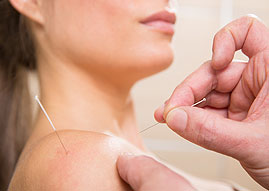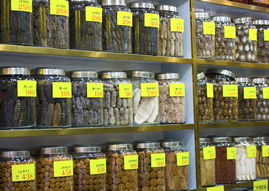Practicing Compassionate Medicine
Is acupuncture painful?

Most people find acupuncture relaxing. Acupuncture needles are very fine, about the size of a human hair. When a needle is inserted, the patient may feel a slight pressure, tingling, heaviness, or mild electric sensation. Often a needle can't be felt at all. While some points may be more sensitive than others, every effort is made to insert the needle without discomfort.
Are acupuncture needles safe?

Only sterilized, single-use, disposable needles are used. Most often, needles are only inserted to a depth of 1/4" to 1" depending on the nature of the treatment.
How many acupuncture treatments will I need?

The number of treatments varies according to the nature of both the patient and the complaint. Some conditions need only a few treatments while other chronic problems may require a longer series.
Should I try acupuncture only when I'm ill?

No. Acupuncture and Oriental medicine is highly effective as preventative medicine. TCM is also an effective modality for reducing stress, enhancing immunity, and promoting general health.
Are Chinese herbs safe?

All of the herbs in our pharmacy are grown and manufactured under the strictest of regulations, receiving the GMP (Good Manufacturing Practice) seal of approval. Chinese herbs typically have far fewer side effects than Western drugs, including over-the-counter medicines, such as Tylenol. You should always inform both your Western M.D. and TCM practitioner of any prescription drugs, over-the-counter medicines, herbs, or supplements you are taking so possible interactions between herbs and Western drugs may be avoided. Such interactions are very rare and occur mainly when herbs are abused. The recent use of ephedra in weight-loss supplements is one such example.
Qi
Everything Is Energy
It’s impossible to say anything about TCM without talking about Qi (chee), the energy or life force within you and all around you. It’s all energy; everything is energy. We know this now from discoveries in modern physics.
When you break solid matter down into smaller and smaller portions, there is nothing solid or physical about it at all—it’s just invisible energy. So the basic “building block” of everything in nature and the universe, including our own bodies, is energy.
TCM’s Deep Understanding of Qi
Energy or Qi, as the Chinese express it, is at the very heart of TCM. With thousands of years of direct observation and deep experiential knowledge of Qi, this holistic medicine has a complete understanding of energy and how it moves and functions in the body and throughout nature. TCM’s deep insight and expertise on energy are what make it a profoundly accurate and effective healing system.
Excerpted from: Traditional Chinese Medicine World Foundation
More about QiYin and Yang
Opposite yet Complementary Energies
Everything contains Yin and Yang. They are two opposite yet complementary energies. What does this really mean? Although they are totally different—opposite—in their individual qualities and nature, they are interdependent. Yin and Yang cannot exist without the other; they are never separate. For example, night and day form a Yin-Yang pair. (Night is Yin and day is Yang.) Night looks and is very different than day, yet it is impossible to have one without the other. Both create a totality, a complete whole.
A Theory Fundamental to TCM Practice
The theory of Yin and Yang is fundamental to the practice of TCM in terms of understanding, diagnosing, and treating health issues. At the most basic and deep level, TCM treatment seeks to balance Yin and Yang in each person. One ancient TCM text expressed the power and importance of Yin and Yang this way: “If you can understand Yin and Yang you can hold the universe in your hands.”
Excerpted from: Traditional Chinese Medicine World Foundation
More about Yin & YangThe Five Elements
A Comprehensive Template Reflecting Natural Law
The Five Elements are a comprehensive template that organizes all natural phenomena into five master groups or patterns in nature. Each of the five groups—Wood, Fire, Earth, Metal, and Water—include categories such as a season, a direction, climate, stage of growth and development, internal organ, body tissue, emotion, aspect of the soul, taste, color, sound . . . the categories are seemingly limitless. The Five Elements reflect a deep understanding of natural law, the Universal order underlying all things in our world.
Five Element Framework
It provides a master blueprint that diagrams how nature interacts with the body and how the different dimensions of our being impact each other. When studying the Five Element Framework it is important to emphasize that this multi-dimensional view of life offers a diagnostic framework to recognize where imbalances—body, mind, emotions, and spirit lie. The Five Elements include the internal organs, and the interconnected relationships between them.
Excerpted from: Traditional Chinese Medicine World Foundation
More on The 5 Elements Five Elements Chart - PDFThe Three Treasures
Jing, Qi and Shen
There are three treasures in the human body. These are known as jing, qi (pronounced "chee") and shen. The ultimate goal of all of the Oriental healing and health-promoting arts is to cultivate, balance and expand the Three Treasures. At the highest level of the Oriental healing arts, the practitioner is attempting to harmonize all aspects of one's being. This is accomplished by focusing one's attention on the Three Treasures. There are no exact translations for the terms jing, qi and shen into English. They are generally translated, though, as essence, vitality and spirit.
Information presented here on the 3 Treasures was comprised from information gained from but not limited to the following sites: Confucius Institute | Hippocrates Health Institute | New World Encyclopedia | Sacred Lotus Chinese Medicine | Wikipedia - Three Treasures (traditional Chinese medicine)
The First Treasure - JING "essence"
Jing is the refined energy of the body. It provides the foundation for all activity and is said to be the "root" of our vitality. Jing is the primal energy of life and is closely associated with our genetic potential and the aging process. Jing is stored energy and provides the reserves required to adapt to all the various stresses encountered in life.
When jing is strong, vitality and youthfulness remain. Strong jing energy in the kidneys, will lead to a long and vigorous life. Jing is essential to life and when it runs low our life force is severely diminished, thus we lose all power to adapt. The quantity of essence determines both our life span and the ultimate vitality of our life. There are three aspects/essences to Jing: Prenatal Jing, Postnatal Jing & Kidney Jing.
There are special herbal tonics that fortify jing, that replace spent jing and that build up large reserves for future use.
The Second Treasure - QI "vitality"
Qi, is the energy that creates our vitality. Through the constant interaction of yin and yang, the two moving powers of the universe, change is brought into being and life exists. Qi is the activity of yin and yang. All movement, all functioning and all thought is the result of qi. Qi is said to be produced as a result of the functions of the lungs and spleen.
Fast moving Qi is considered to be Yang while slow moving Qi is Yin. In the system of the Three Treasures, blood is considered to be a part of the Qi component of our being.
Qi tonics strengthen the digestive, assimilative and respiratory functions. Qi tonics also increase the amount, and improve the quality of the energy and blood flowing through our system. This increase in energy and blood results in an overall increase in physical and mental vitality.
The Third Treasure - SHEN "spirit"
Shen is the guiding spirit, which directs qi. This is ultimately the most important of the Three Treasures because it reflects our higher nature as human beings. Chinese masters say that shen is the all-embracing love that resides in our heart. Shen is the spiritual radiance of a human being and is the ultimate and most refined level of energetics in the universe.
Certain true shen tonics encourage the opening up of shen. There are shen "stabilizers" which help stabilize our emotions so that shen (our higher being) can rule our lives. Shen tonics have been used by the great sages of the Orient to help in their quest for enlightenment and harmony with God, nature and all of mankind.
Tonic herbs can be categorized as jing (yin and/or yang), qi (energy and/or blood) and shen (opening and/or stabilizing) by virtue of which of the Three Treasures they tend to nourish and develop. Applying the principle of the Three Treasures is the highest form of herbalism.
An Introduction to Traditonal Chinese Medicine - PDFZang-Fu Function
Zang-Fu
The term zàng refers to the organs considered to be yin in nature – Heart, Liver, Spleen, Lung, Kidney – while fǔ refers to the yang organs – Small Intestine, Large Intestine, Gall Bladder, Urinary Bladder, Stomach and Sānjiaō (all three areas of the body cavity).
Medicinal Herbs
It is believed that illness is the reflection of the waning and waxing of yin and yang in the body. The basic concept of medicinal herbs is to restore and adjust the normal Zang-fu function, there-by correcting the pathological changes caused by the inbalance between Yin and Yang.
More about Zang-FuThe Meridian System
Meridian
The term ‘meridian’ describes the overall energy distribution system of Chinese Medicine and helps us to understand how basic substances of the body (Qi, blood and body fluids) permeate the whole body. The individual meridians themselves are often described as ‘channels’ or even ‘vessels’ which reflects the notion of carrying, holding, or transporting qi, blood and body fluids around the body.
Twelve Standard Meridians
There are twelve standard meridians, or invisible channels, throughout the body which Qi or energy flows. Each limb is traversed by six channels, three Yin channels on the inside, and three Yang channels on the outside. Each of the twelve regular channels corresponds to the five Yin organs, the six Yang organs as well as the Pericardium and San Jiao - ('San' means three, 'Jiao' means 'burn' - a functional energy system involved in regulating the activities of other organs).
More about Meridians